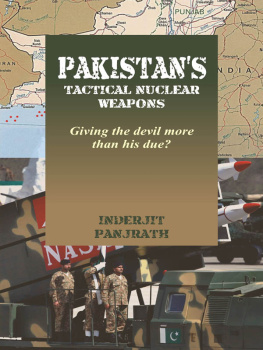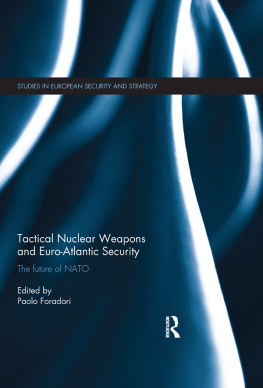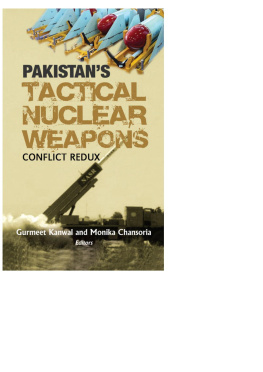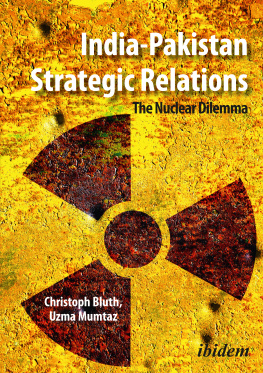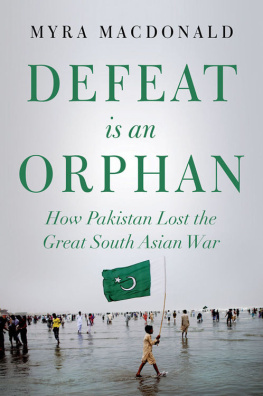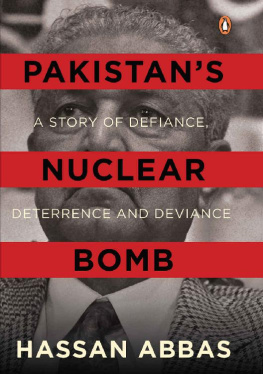PAKISTANS
TACTICAL NUCLEAR
WEAPONS
Giving the devil more than his due?
The challenge for the strategistsindeed, the essence of strategy is to force
or persuade those who are hostile or unsympathetic to act differently than
their current intention.
Lawrence Freedman
PAKISTANS
TACTICAL NUCLEAR
WEAPONS
Giving the devil more than his due?
INDERJIT PANJRATH
United Service Institution of India
New Delhi
Vij Books India Pvt Ltd
New Delhi (India)
Published by
Vij Books India Pvt Ltd
(Publishers, Distributors & Importers)
2/19, Ansari Road
Delhi 110 002
Phones: 91-11-43596460, 91-11-47340674
Fax: 91-11-47340674
e-mail:
Copyright 2018, United Service Institution of India, New Delhi
ISBN: 978-93-86457-60-8 (Hardback)
ISBN: 978-93-86457-61-5 (ebook)
All rights reserved.
No part of this book may be reproduced, stored in a retrieval system, transmitted or utilised
in any form or by any means, electronic, mechanical, photocopying, recording or otherwise,
without the prior permission of the copyright owner. Application for such permission should
be addressed to the publisher.
Cover Credits
Jaskirat S Panjrath

That nuclear weapons have always had an important role in Pakistans strategic calculus vis--vis India is common knowledge. Her policy makers have never missed an opportunity for nuclear sabre rattling in any of the conflict situations between the two nations since her humiliating loss in the Indo-Pak War of 1971. Despite disconcerting and worried voices from most Western think tanks regarding possible Nuclear Armageddon in South Asia, none of these conflicts have escalated beyond a point not even into a full-fledged conventional war. While demonstrating immense patience, often labelled as strategic restraint by some and sheer inaction by others, India has never shied away from use of force whenever absolutely necessary. The military response to incursions in Kargil in 1999 or the very recent strikes by Indian Para SF teams on terrorist launch pads across the LoC, following the terror attack in Uri has established beyond doubt that there is no lack of resolve to retaliate appropriately despite the threat of nuclear weapons by the adversary.
Pakistans Deep State, however continues to come up with ingenious ways to persist with its policy of inflicting a thousand cuts on India. The induction of Tactical Nuclear Weapons (TNWs) in its arsenal with an aim of achieving full spectrum deterrence is another such attempt one which it believes would deny to Indian Armed Forces the space for a conventional conflict or a military response while it continues to fuel the proxy war in Jammu & Kashmir. Is this a correct assessment? Will the threat of TNWs, indeed, prevent a military response from India in case of a future conflict? Does the Indo-Pak nuclear balance stand altered? Does this contribute to the strategic stability Pakistan claims to seek or does it further exacerbate the already fragile Indo-Pak security paradigm by contributing to instability and fuel escalation in a future conflict? These are some of the questions for which answers have been attempted.
The author, by means of a balanced analysis based on both technical capabilities of Pakistans TNWs as well as a realistic assessment of strategic drivers of conflict in the region concludes that the TNWs remain weapons of mere signalling, with negligible deterrence capabilities vis--vis India. Hence, these would not provide her the full spectrum deterrence or strategic stability it seeks. Instead, they possess the potential to adversely alter the deterrence dynamics towards greater instability and possible escalation in any future conflict. For India, while its Grand Strategy would continue to focus on economic growth to achieve Great Power Status, should it be pushed beyond a point, it would not hesitate in responding appropriately, as it has done in the past the threat of lowered nuclear threshold notwithstanding. However, it must evolve strategic options and capabilities to support these, so as to ensure that Pakistan is effectively compelled to refrain from sponsoring terror on Indian soil.
Coming at a time when the conflict dynamics in the region are undergoing a transition like never before, this study could not have been better timed. The book is an important and valuable contribution as it attempts to view implications of Pakistans TNWs, not just towards nuclear deterrence but in the overall context of the Indo-Pak conflict continuum across all three planes i.e. sub-conventional, conventional. In doing so, certain plausible options for India have been suggested.
It gives me immense pleasure to congratulate Col Inderjit S Panjrath, SM on successful completion of his maiden work as also to the Centre for Strategic Studies and Simulation (CS3), USI of India, New Delhi for their guidance, support and encouragement to the author.
New Delhi
Lt Gen PK Singh, PVSM, AVSM (Retd)
Oct 2017
Director, USI of India, New Delhi
This work would not have been possible without the intellectual, inspirational and the administrative support of the United Service Institution (USI) of India. I am especially grateful to Maj Gen BK Sharma, AVSM, SM** (Retd), Deputy Director (Research) and Head Centre for Strategic Research and Simulation (CS3), who not only helped me in choosing this topic for research, but also continuously guided me throughout the research work. I am also particularly indebted to Dr Roshan Khaniejo, Research Coordinator at CS3 who, as my guide and mentor, has taught me more than I could ever give her credit for here. She has shown me, by her example, what a good researcher (and person) should be.
I am grateful to all my colleagues and peers at the USI and CS3 with whom I have had the honour to work and interact during this project. Each member of the faculty at CS3 and other wings at the USI has provided me extensive personal and professional guidance and taught me a great deal about both strategic research and life in general. I would especially like to thank Lt Gen PK Singh, PVSM, AVSM (Retd) Dir USI, Lt Gen Chander Prakash, VSM (Retd), Maj Gen Rajiv Narayanan, AVSM, VSM (Retd), Maj Gen RPS Bhadauria, VSM (Retd) and Maj Gen SB Asthana SM, VSM (Retd) who have been supportive of my ideas and who worked actively to provide me with requisite inputs based on years of experience to give shape to this research. I would be failing in my duty if do not express my heartfelt thanks to Maj Gen PK Goswami, AVSM, VSM (Retd), Deputy Director Administration and the entire staff of USI for not only creating an ideal environment for research but for being ever available for any sort of administrative support on a day to day basis.
During the course of the research, I was fortunate to have interacted directly and indirectly as also formally and informally with eminent scholars dealing with the subjects of Nuclear Weapons as well as Indo-Pak relations. This could be possible only due to the institutional support provided by the USI which entitled me to attend numerous seminars organised by various thinks tanks. I would like to convey my special thanks to Lt Gen Vinod Bhatia, PVSM, AVSM, SM (Retd) Director CENJOWS, Dr Rajiv Nayan of the IDSA, Col Amit Rao and Col SB Rai, both scholars at CLAWS for their valuable inputs. I am also grateful to Brig Gurmeet Kanwal (Retd), who very magnanimously allowed me to further build on a basic scenario initiated by him, for the purpose of this research.

